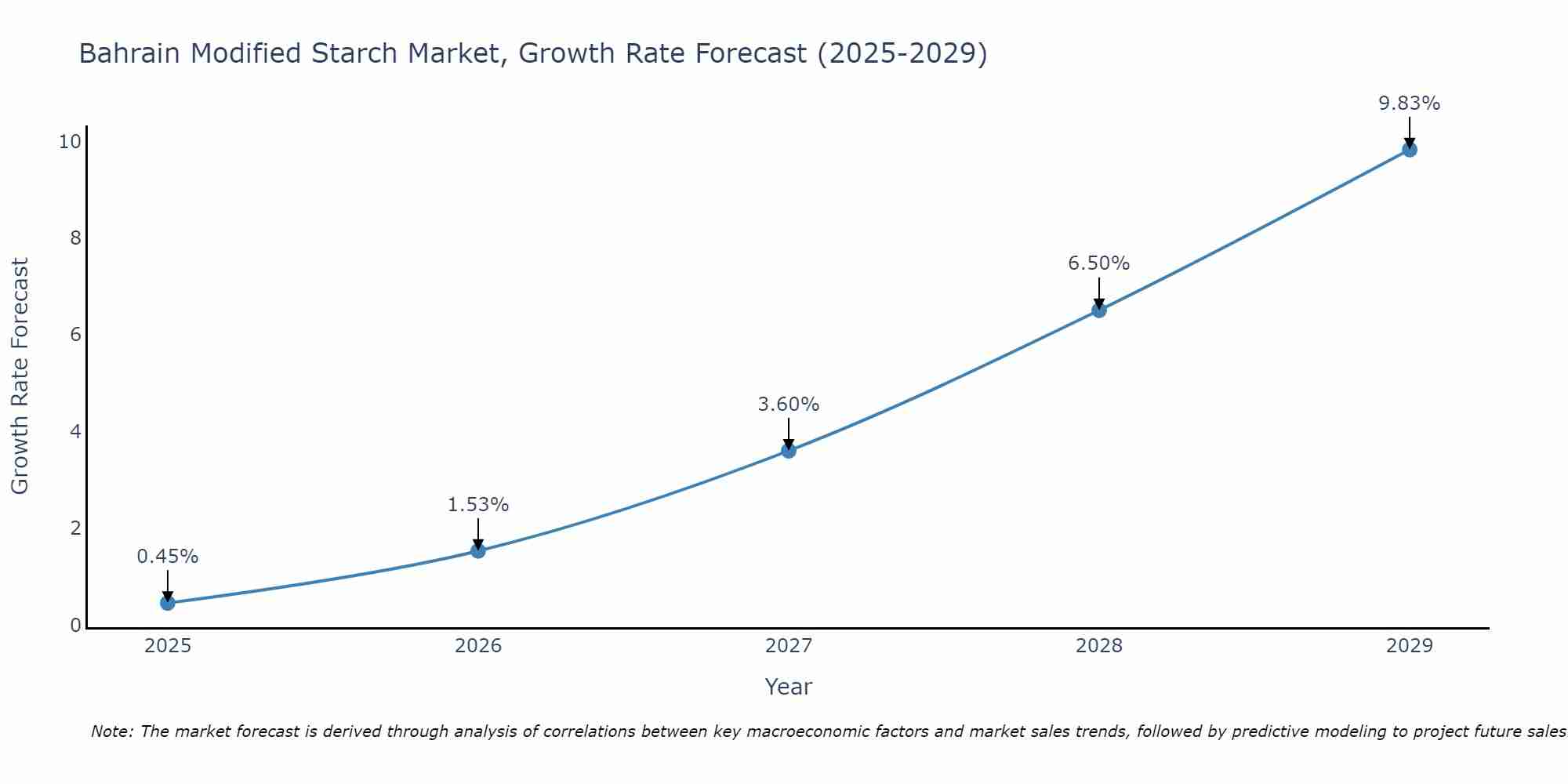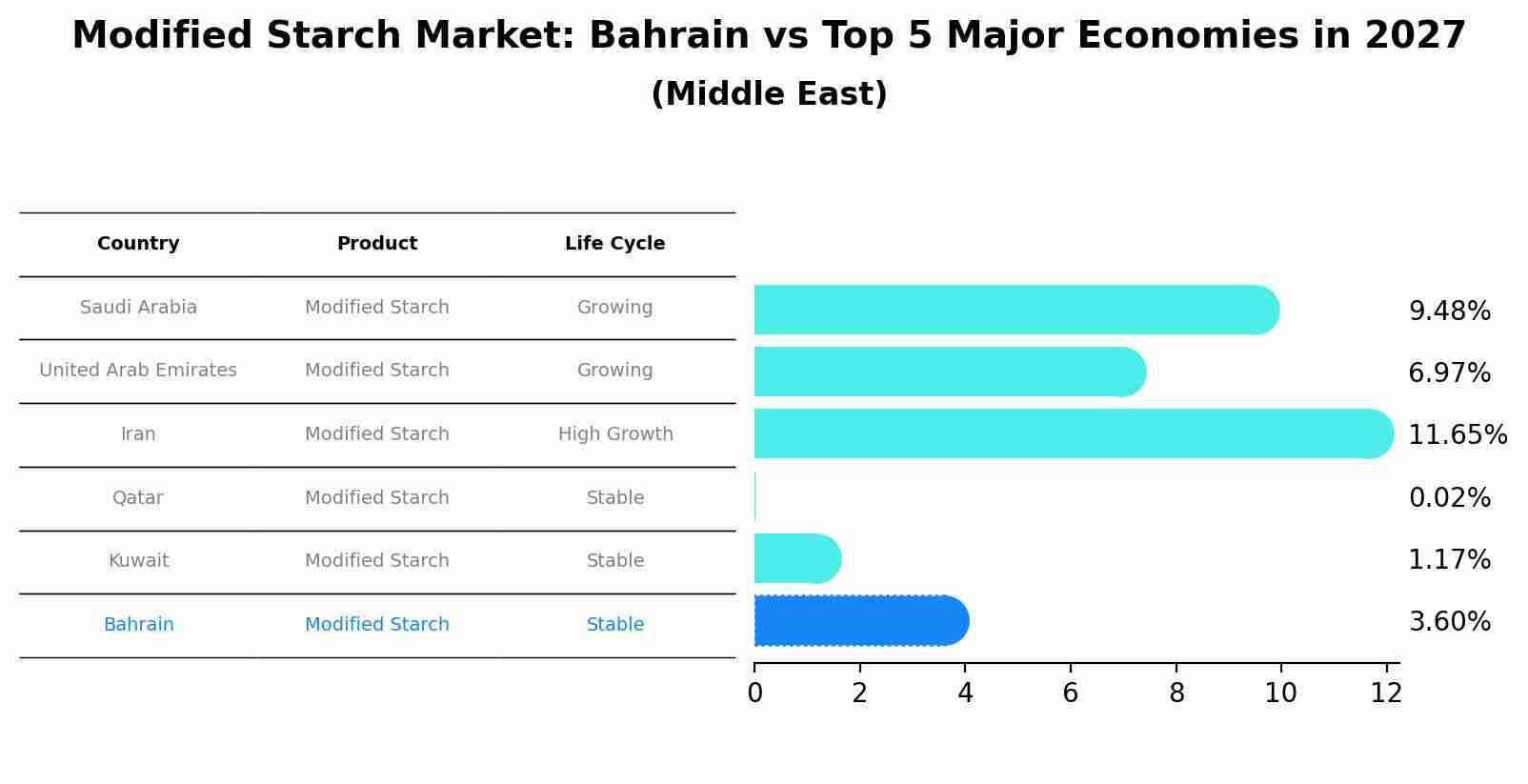Bahrain Modified Starch Market | Industry, COVID-19 IMPACT, Size, Companies, Value, Revenue, Trends, Analysis, Growth, Outlook, Forecast & Share
| Product Code: ETC170163 | Publication Date: Jan 2022 | Updated Date: Apr 2025 | Product Type: Market Research Report | |
| Publisher: 6Wresearch | Author: Ravi Bhandari | No. of Pages: 70 | No. of Figures: 35 | No. of Tables: 5 |
Bahrain Modified Starch Market Size Growth Rate
The Bahrain Modified Starch Market is poised for steady growth rate improvements from 2025 to 2029. From 0.45% in 2025, the growth rate steadily ascends to 9.83% in 2029.

Modified Starch Market: Bahrain vs Top 5 Major Economies in 2027 (Middle East)
In the Middle East region, the Modified Starch market in Bahrain is projected to expand at a stable growth rate of 3.60% by 2027. The largest economy is Saudi Arabia, followed by United Arab Emirates, Iran, Qatar and Kuwait.

Bahrain Modified Starch Market Overview
Bahrain`s modified starch market is expected to grow steadily, driven by its increasing applications in the food, pharmaceutical, and paper industries. Modified starches are used as thickeners, stabilizers, and emulsifiers in food products and are also employed in the production of biodegradable packaging. With a growing demand for convenience foods and the rising need for eco-friendly packaging solutions, the market for modified starch is set to expand in Bahrain.
Drivers of the market
The Bahrain modified starch market is driven by the growing demand for processed and convenience foods in the country. Modified starch is widely used as a thickening, stabilizing, and gelling agent in food products such as sauces, soups, and bakery items. The increasing consumer preference for ready-to-eat and processed foods, along with the expanding food processing industry in Bahrain, is fueling the demand for modified starch. Additionally, the use of modified starch in non-food applications, including pharmaceuticals, textiles, and paper manufacturing, is supporting market growth. As the demand for versatile and functional ingredients continues to rise, the modified starch market is expected to grow in Bahrain.
Challenges of the market
The modified starch market in Bahrain encounters challenges due to the limited scale of the local food processing and industrial sectors, which are the primary consumers of modified starch. The country relies heavily on imports for raw materials, increasing production costs and exposing the market to global supply chain disruptions. Additionally, competition from other thickening and stabilizing agents, such as gums and synthetic additives, affects the demand for modified starch in various applications. Environmental regulations surrounding the use of genetically modified crops, which are often used to produce modified starch, also pose challenges for market growth.
Investment opportunities in the Market
Modified starches are used in food processing, pharmaceuticals, and textiles. Bahrains food processing and industrial sectors offer investment opportunities in the modified starch market. Investors can target food manufacturers, pharmaceutical companies, and textile producers by supplying versatile modified starches that enhance product quality and functionality in various applications.
Government Policy of the market
The modified starch market in Bahrain is driven by demand from industries such as food, textiles, and pharmaceuticals. Government policies promoting local food production, industrial diversification, and the development of the manufacturing sector have contributed to the growth of this market. Regulatory frameworks ensure the safety and quality of modified starch, especially in food-grade applications where strict standards must be adhered to. The governments support for local manufacturing and agriculture further boosts the market for modified starch, aiding its use in various industries.
Key Highlights of the Report:
- Bahrain Modified Starch Market Outlook
- Market Size of Bahrain Modified Starch Market, 2021
- Forecast of Bahrain Modified Starch Market, 2031
- Historical Data and Forecast of Bahrain Modified Starch Revenues & Volume for the Period 2018 - 2031
- Bahrain Modified Starch Market Trend Evolution
- Bahrain Modified Starch Market Drivers and Challenges
- Bahrain Modified Starch Price Trends
- Bahrain Modified Starch Porter's Five Forces
- Bahrain Modified Starch Industry Life Cycle
- Historical Data and Forecast of Bahrain Modified Starch Market Revenues & Volume By Source for the Period 2018 - 2031
- Historical Data and Forecast of Bahrain Modified Starch Market Revenues & Volume By Corn for the Period 2018 - 2031
- Historical Data and Forecast of Bahrain Modified Starch Market Revenues & Volume By Wheat for the Period 2018 - 2031
- Historical Data and Forecast of Bahrain Modified Starch Market Revenues & Volume By Cassava for the Period 2018 - 2031
- Historical Data and Forecast of Bahrain Modified Starch Market Revenues & Volume By Potato for the Period 2018 - 2031
- Historical Data and Forecast of Bahrain Modified Starch Market Revenues & Volume By Application for the Period 2018 - 2031
- Historical Data and Forecast of Bahrain Modified Starch Market Revenues & Volume By Food & Beverages for the Period 2018 - 2031
- Historical Data and Forecast of Bahrain Modified Starch Market Revenues & Volume By Animal Feed for the Period 2018 - 2031
- Historical Data and Forecast of Bahrain Modified Starch Market Revenues & Volume By Others for the Period 2018 - 2031
- Bahrain Modified Starch Import Export Trade Statistics
- Market Opportunity Assessment By Source
- Market Opportunity Assessment By Application
- Bahrain Modified Starch Top Companies Market Share
- Bahrain Modified Starch Competitive Benchmarking By Technical and Operational Parameters
- Bahrain Modified Starch Company Profiles
- Bahrain Modified Starch Key Strategic Recommendations
Frequently Asked Questions About the Market Study (FAQs):
1 Executive Summary |
2 Introduction |
2.1 Key Highlights of the Report |
2.2 Report Description |
2.3 Market Scope & Segmentation |
2.4 Research Methodology |
2.5 Assumptions |
3 Bahrain Modified Starch Market Overview |
3.1 Bahrain Country Macro Economic Indicators |
3.2 Bahrain Modified Starch Market Revenues & Volume, 2021 & 2031F |
3.3 Bahrain Modified Starch Market - Industry Life Cycle |
3.4 Bahrain Modified Starch Market - Porter's Five Forces |
3.5 Bahrain Modified Starch Market Revenues & Volume Share, By Source, 2021 & 2031F |
3.6 Bahrain Modified Starch Market Revenues & Volume Share, By Application, 2021 & 2031F |
4 Bahrain Modified Starch Market Dynamics |
4.1 Impact Analysis |
4.2 Market Drivers |
4.3 Market Restraints |
5 Bahrain Modified Starch Market Trends |
6 Bahrain Modified Starch Market, By Types |
6.1 Bahrain Modified Starch Market, By Source |
6.1.1 Overview and Analysis |
6.1.2 Bahrain Modified Starch Market Revenues & Volume, By Source, 2021-2031F |
6.1.3 Bahrain Modified Starch Market Revenues & Volume, By Corn, 2021-2031F |
6.1.4 Bahrain Modified Starch Market Revenues & Volume, By Wheat, 2021-2031F |
6.1.5 Bahrain Modified Starch Market Revenues & Volume, By Cassava, 2021-2031F |
6.1.6 Bahrain Modified Starch Market Revenues & Volume, By Potato, 2021-2031F |
6.2 Bahrain Modified Starch Market, By Application |
6.2.1 Overview and Analysis |
6.2.2 Bahrain Modified Starch Market Revenues & Volume, By Food & Beverages, 2021-2031F |
6.2.3 Bahrain Modified Starch Market Revenues & Volume, By Animal Feed, 2021-2031F |
6.2.4 Bahrain Modified Starch Market Revenues & Volume, By Others, 2021-2031F |
7 Bahrain Modified Starch Market Import-Export Trade Statistics |
7.1 Bahrain Modified Starch Market Export to Major Countries |
7.2 Bahrain Modified Starch Market Imports from Major Countries |
8 Bahrain Modified Starch Market Key Performance Indicators |
9 Bahrain Modified Starch Market - Opportunity Assessment |
9.1 Bahrain Modified Starch Market Opportunity Assessment, By Source, 2021 & 2031F |
9.2 Bahrain Modified Starch Market Opportunity Assessment, By Application, 2021 & 2031F |
10 Bahrain Modified Starch Market - Competitive Landscape |
10.1 Bahrain Modified Starch Market Revenue Share, By Companies, 2021 |
10.2 Bahrain Modified Starch Market Competitive Benchmarking, By Operating and Technical Parameters |
11 Company Profiles |
12 Recommendations |
13 Disclaimer |
- Single User License$ 1,995
- Department License$ 2,400
- Site License$ 3,120
- Global License$ 3,795
Search
Related Reports
- Australia IT Asset Disposal Market (2025-2031) | Strategy, Consumer Insights, Analysis, Investment Trends, Opportunities, Growth, Size, Share, Industry, Revenue, Segments, Value, Segmentation, Supply, Forecast, Restraints, Outlook, Competition, Drivers, Trends, Demand, Pricing Analysis, Competitive, Strategic Insights, Companies, Challenges
- UAE Building Thermal Insulation Market Outlook (2025-2031) | Revenue, Companies, Share, Trends, Growth, Size, Forecast, Industry, Analysis & Value
- Portugal Electronic Document Management Market (2025-2031) | Strategy, Consumer Insights, Analysis, Investment Trends, Opportunities, Growth, Size, Share, Industry, Revenue, Segments, Value, Segmentation, Supply, Forecast, Restraints, Outlook, Competition, Drivers, Trends, Demand, Pricing Analysis, Competitive, Strategic Insights, Companies, Challenges
- France Electronic Document Management Market (2025-2031) | Strategy, Consumer Insights, Analysis, Investment Trends, Opportunities, Growth, Size, Share, Industry, Revenue, Segments, Value, Segmentation, Supply, Forecast, Restraints, Outlook, Competition, Drivers, Trends, Demand, Pricing Analysis, Competitive, Strategic Insights, Companies, Challenges
- Portugal Occupational Health & Safety Services Market (2025-2031) | Strategy, Consumer Insights, Analysis, Investment Trends, Opportunities, Growth, Size, Share, Industry, Revenue, Segments, Value, Segmentation, Supply, Forecast, Restraints, Outlook, Competition, Drivers, Trends, Demand, Pricing Analysis, Competitive, Strategic Insights, Companies, Challenges
- Netherlands Occupational Health and Safety Services Market (2025-2031) | Strategy, Consumer Insights, Analysis, Investment Trends, Opportunities, Growth, Size, Share, Industry, Revenue, Segments, Value, Segmentation, Supply, Forecast, Restraints, Outlook, Competition, Drivers, Trends, Demand, Pricing Analysis, Competitive, Strategic Insights, Companies, Challenges
- Belgium and Luxembourg Facility Management Market (2025-2031) | Strategy, Consumer Insights, Analysis, Investment Trends, Opportunities, Growth, Size, Share, Industry, Revenue, Segments, Value, Segmentation, Supply, Forecast, Restraints, Outlook, Competition, Drivers, Trends, Demand, Pricing Analysis, Competitive, Strategic Insights, Companies, Challenges
- Russia Women Intimate Apparel Market (2025-2031) | Strategy, Consumer Insights, Analysis, Investment Trends, Opportunities, Growth, Size, Share, Industry, Revenue, Segments, Value, Segmentation, Supply, Forecast, Restraints, Outlook, Competition, Drivers, Trends, Demand, Pricing Analysis, Competitive, Strategic Insights, Companies, Challenges
- Africa Chocolate Market (2025-2031) | Size, Share, Trends, Growth, Revenue, Analysis, Forecast, industry & Outlook
- Global Hydroxychloroquine And Chloroquine Market (2025-2031) | Industry, Trends, Size, Outlook, Growth, Value, Companies, Revenue, Analysis, Share, Forecast
Industry Events and Analyst Meet
Our Clients
Whitepaper
- Middle East & Africa Commercial Security Market Click here to view more.
- Middle East & Africa Fire Safety Systems & Equipment Market Click here to view more.
- GCC Drone Market Click here to view more.
- Middle East Lighting Fixture Market Click here to view more.
- GCC Physical & Perimeter Security Market Click here to view more.
6WResearch In News
- Doha a strategic location for EV manufacturing hub: IPA Qatar
- Demand for luxury TVs surging in the GCC, says Samsung
- Empowering Growth: The Thriving Journey of Bangladesh’s Cable Industry
- Demand for luxury TVs surging in the GCC, says Samsung
- Video call with a traditional healer? Once unthinkable, it’s now common in South Africa
- Intelligent Buildings To Smooth GCC’s Path To Net Zero













